Komodo National Park includes three major islands: Komodo, Rinca and Padar, as well as numerous smaller islands creating a total surface area (marine and land) of 1817km (proposed extensions would bring the total surface area up to 2,321km2). As well as being home to the Komodo dragon, the Park provides refuge for many other notable terrestrial species such as the orange-footed scrub fowl, an endemic rat, and the Timor deer. Moreover, the Park includes one of the richest marine environments including coral reefs, mangroves, seagrass beds, seamounts, and semi-enclosed bays. These habitats harbor more than 1,000 species of fish, some 260 species of reef-building coral, and 70 species of sponges. Dugong, sharks, manta rays, at least 14 species of whales, dolphins, and sea turtles also make Komodo National Park their home.
 |

Threats to terrestrial biodiversity include the increasing pressure on forest cover and water resources as the local human population has increased 800% over the past 60 years. In addition, the Timor deer population, the preferred prey source for the endangered Komodo dragon, is still being poached. Destructive fishing practices such as dynamite-, cyanide, and compressor fishing severely threaten the Park's marine resources by destroying both the habitat (coral reefs) and the resource itself (fish and invertebrate stocks). The present situation in the Park is characterized by reduced but continuing destructive fishing practices primarily by immigrant fishers, and high pressure on demersal stocks like lobsters, shellfish, groupers and napoleon wrasse. Pollution inputs, ranging from raw sewage to chemicals, are increasing and may pose a major threat in the future.



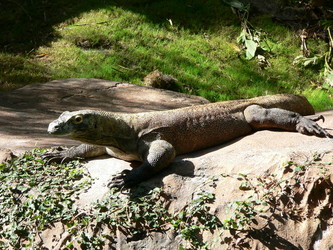
The Komodo dragon (Varanus komodoensis) is a species of lizard that inhabits the islands of Komodo, Rinca, Flores, Gili Motang, and Gili Dasami, in central Indonesia. A member of the monitor lizard family (Varanidae), it is the largest living species of lizard, growing to an average length of 2–3 meters (approximately 6.5–10 ft) and weighing around 70 kilograms (154 lb). Their unusual size is attributed to island gigantism, since there are no other carnivorous animals to fill the niche on the islands where they live, and also to the Komodo dragon's low metabolic rate. As a result of their size, these lizards are apex predators, dominating the ecosystems in which they live. Although Komodo dragons eat mostly carrion, they will also hunt and ambush prey including invertebrates, birds, and mammals.

Mating begins between May and August, and the eggs are laid in September. About twenty eggs are deposited in abandoned megapode nests and incubated for seven to eight months, hatching in April, when insects are most plentiful. Young Komodo dragons are vulnerable and therefore dwell in trees, safe from predators and cannibalistic adults. They take around three to five years to mature, and may live as long as fifty years. They are capable of parthenogenesis, in which viable eggs are laid without fertilization by a male.

Komodo dragons were discovered by Western scientists in 1910. Their large size and fearsome reputation makes them popular zoo exhibits. In the wild their range has contracted due to human activities and they are listed as vulnerable by the IUCN. They are protected under Indonesian law, and a national park, Komodo National Park, was founded to aid protection efforts.
The Komodo dragon is also known as the Komodo Monitor or the Komodo Island Monitor in scientific literature, although this is not very common. To the natives of Komodo Island, it is referred to as ora, buaya darat (land crocodile) or biawak raksasa (giant monitor).
Evolution
The evolutionary development of the Komodo dragon started with the Varanus genus, which originated in Asia about 40 million years ago and migrated to Australia. Around 15 million years ago, a collision between Australia and Southeast Asia allowed the Varanids to move into what is now the Indonesian archipelago. The Komodo dragon is believed to have differentiated from its Australian ancestors 4 million years ago, extending their range to as far east as the island of Timor. The Ice Age and its dramatic sea level changes brought the islands that the Komodo dragons inhabited into their present locations, isolating them in their present range.
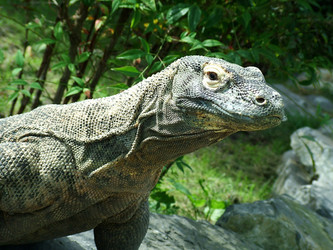

Description
In the wild, an adult Komodo dragon usually weighs around 70 kilograms (154 lb), although captive specimens often weigh more. The largest verified wild specimen was 3.13 meters (10 ft 3 in) long and weighed 166 kilograms (365 lb), including undigested food. The Komodo dragon has a tail as long as its body, as well as about 60 frequently-replaced serrated teeth that can measure up to 2.5 centimeters (1 inch) in length. Its saliva is frequently blood-tinged, because its teeth are almost completely covered by gingival tissue that is naturally lacerated during feeding. This creates an ideal culture for the virulent bacteria that live in its mouth. It also has a long, yellow, deeply-forked tongue.
Senses
The Komodo dragon does not have a particularly acute sense of hearing, despite its visible earholes, and is only able to hear sounds between 400 and 2000 hertz.] It is able to see as far away as 300 meters (985 feet), but because its retinas only contain cones, it is thought to have poor night vision. The Komodo dragon is able to see in color, but has poor visual discrimination of stationary objects.

The Komodo dragon uses its tongue to detect taste and smell stimuli, as with many other reptiles, with the vomeronasal sense using a Jacobson's organ, a sense that aids navigation in the dark. With the help of a favorable wind and its habit of swinging its head from side to side as it walks, Komodo dragons may be able to detect carrion from 4–9.5 kilometres (2.5–6 mi) away. The dragon's nostrils are not of great use for smelling, as the animal does not have a diaphragm. It only has a few taste buds in the back of its throat. Its scales, some of which are reinforced with bone, have sensory plaques connected to nerves that facilitate its sense of touch. The scales around the ears, lips, chin, and soles of the feet may have three or more sensory plaques.
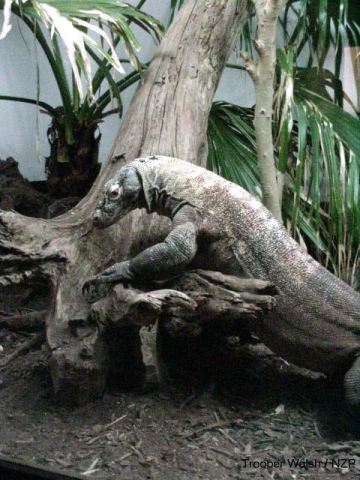
The Komodo dragon was formerly thought to be deaf when a study reported no agitation in wild Komodo dragons in response to whispers, raised voices, or shouts. This was disputed when London Zoological Garden employee Joan Proctor trained a captive specimen to come out to feed at the sound of her voice, even when she could not be seen.
Ecology
The Komodo dragon prefers hot and dry places, and typically lives in dry open grassland, savanna, and tropical forest at low elevations. As an ectotherm, it is most active in the day, although it exhibits some nocturnal activity. Komodo dragons are largely solitary, coming together only to breed and eat. They are capable of running rapidly in brief sprints up to 20 kilometres per hour (12.4 mph), diving up to 4.5 metres (15 ft), and climbing trees proficiently when young through use of their strong claws. To catch prey that is out of reach, the Komodo dragon may stand on its hind legs and use its tail as a support. As the Komodo dragon matures, its claws are used primarily as weapons, as its great size makes climbing impractical.
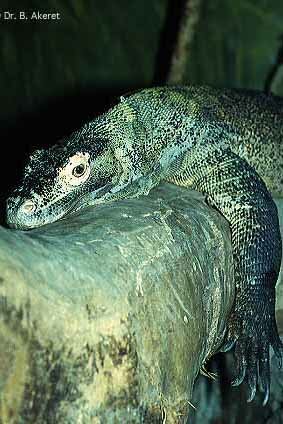

For shelter, the Komodo dragon digs holes that can measure from 1–3 metres (3–10 ft) wide with its powerful forelimbs and claws. Because of its large size and habit of sleeping in these burrows, it is able to conserve body heat throughout the night and minimize its basking period the morning after. The Komodo dragon typically hunts in the afternoon, but stays in the shade during the hottest part of the day. These special resting places, usually located on ridges with a cool sea breeze, are marked with droppings and are cleared of vegetation. They also serve as a strategic location from which to ambush deer.
Diet
Komodo dragons are carnivores. Although they eat mostly carrion, they will also ambush live prey with a stealthy approach. When suitable prey arrives near a dragon's ambush site, it will suddenly charge at the animal and go for the underside or the throat. It is able to locate its prey using its keen sense of smell, which can locate a dead or dying animal from a range of up to 9.5 kilometers (6 miles). Komodo dragons have also been observed knocking down large pigs and deer with their strong tail.

Komodo dragons eat by tearing large chunks of flesh and swallowing them whole while holding the carcass down with their forelegs. For smaller prey up to the size of a goat, their loosely articulated jaws, flexible skull, and expandable stomach allow it to swallow its prey whole. The vegetable contents of the stomach and intestines are typically avoided. Copious amounts of red saliva that the Komodo dragons produce helps to lubricate the food, but swallowing is still a long process (15–20 minutes to swallow a goat). Komodo dragons may attempt to speed up the process by ramming the carcass against a tree to force it down its throat, sometimes ramming so forcefully that the tree is knocked down. To prevent itself from suffocating while swallowing, it breathes using a small tube under the tongue that connects to the lungs. After eating up to 80 percent of its body weight in one meal, it drags itself to a sunny location to speed digestion, as the food could rot and poison the dragon if left undigested for too long. Because of their slow metabolism, large dragons can survive on as little as 12 meals a year. After digestion, the Komodo dragon regurgitates a mass of horns, hair, and teeth known as the gastric pellet, which is covered in malodorous mucus. After regurgitating the gastric pellet, it rubs its face in the dirt or on bushes to get rid of the mucus, suggesting that it, like humans, does not relish the scent of its own excretions.
The largest animals generally eat first, while the smaller ones follow a hierarchy. The largest male asserts his dominance and the smaller males show their submission by use of body language and rumbling hisses. Dragons of equal size may resort to "wrestling." Losers usually retreat, though have been known to be killed and eaten by victors.
The Komodo dragon's diet is wide-ranging, and includes invertebrates, other reptiles (including smaller Komodo dragons), birds, bird eggs, small mammals, monkeys, wild boar, goats, deer, horses, and water buffalo. Young Komodos will eat insects, eggs, geckos, and small mammals. Occasionally they have been known to consume humans and human corpses, digging up bodies from shallow graves to do so. This habit of raiding graves caused the villagers of Komodo to move their graves from sandy to clay ground and pile rocks on top of them to deter the lizards. The Komodo dragon may have evolved to feed on the extinct dwarf elephant Stegodon that once lived on Flores, according to evolutionary biologist Jared Diamond. The Komodo dragon has also been observed intentionally startling a pregnant deer in the hopes of a miscarriage whose remains they can eat, a technique that has also been observed in large African predators.

Because the Komodo dragon does not have a diaphragm, it cannot suck water when drinking, nor can it lap water with its tongue. Instead, it drinks by taking a mouthful of water, lifting its head, and letting the water run down its throat.
Venom and bacteria
In late 2005, University of Melbourne researchers concluded that the Perentie (Varanus giganteus), other species of monitor, and agamids may be somewhat venomous. It had been thought that bites inflicted by these lizards were prone to infection because of bacteria in the lizards' mouths, but the research team showed that the immediate effects were caused by mild envenomation. Bites on human digits by a Lace Monitor (V. varius), a Komodo dragon, and a Spotted Tree Monitor (V. scalaris) were observed, and all produced similar results in humans: rapid swelling within minutes, localized disruption of blood clotting, shooting pain up to the elbow, with some symptoms lasting for several hours.

Komodo dragons also possess virulent bacteria in their saliva, of which more than 28 Gram-negative and 29 Gram-positive strains have been isolated. These bacteria cause septicemia in their victim; if an initial bite does not kill the prey animal and it escapes, it will commonly succumb within a week to the resulting infection. The deadliest bacteria in Komodo dragon saliva appears to be a very deadly strain of Pasteurella multocida, from studies performed with lab mice. Because the Komodo dragon appears immune to its own microbes, much research has been done searching for the antibacterial molecule in the hopes of human medicinal use.
Reproduction
Mating occurs between May and August, with the eggs laid in September. During this period, males fight over females and territory by grappling with one another upon their hind legs with the loser eventually being pinned to the ground. These males may vomit or defecate when preparing for the fight. The winner of the fight will then flick his long tongue at the female to gain information about her receptivity. Females are antagonistic and resist with their claws and teeth during the early phases of courtship. Therefore, the male must fully restrain the female during coitus to avoid being hurt. Other courtship displays include males rubbing their chins on the female, hard scratches to the back, and licking. Copulation occurs when the male inserts one of his hemipenes into the female's cloaca. Komodo dragons may be monogamous and form "pair bonds", a rare behavior for lizards.
The female lays her eggs in burrows cut into the side of a hill or in the abandoned nesting mounds of the Orange-footed Scrubfowl (a moundbuilder or megapode), with a preference for the abandoned mounds. Clutches contain an average of 20 eggs which have an incubation period of 7–8 months. The female lies on the eggs to incubate and protect them until they hatch around April, at the end of the rainy season when insects are plentiful. Hatching is an exhausting effort for the pups, who break out of their eggshells with an egg tooth that falls off soon after. After cutting out the hatchlings may lie in their eggshells for hours before starting to dig out of the nest. They are born quite defenseless, and many are eaten by predators.


Young Komodo dragons spend much of their first few years in trees, where they are relatively safe from predators, including cannibalistic adults, who make juvenile dragons 10% of their diet. According to David Attenborough, the habit of cannibalism may be advantageous in sustaining the large size of adults, as medium-sized prey on the islands is rare. When the young must approach a kill, they roll around in fecal matter and rest in the intestines of eviscerated animals to deter these hungry adults. Komodo dragons take about three to five years to mature, and may live for up to 50 years.
Parthenogenesis
A Komodo dragon at London Zoo named Sungai laid a clutch of eggs in late 2005 after being separated from male company for more than two years. Scientists initially assumed that she had been able to store sperm from her earlier encounter with a male, an adaptation known as superfecundation. On December 20, 2006, it was reported that Flora, a captive Komodo dragon living in the Chester Zoo in England, was the second known Komodo dragon to have laid unfertilized eggs: she laid 11 eggs, and 7 of them hatched, all of them male. Scientists at Liverpool University in northern England performed genetic tests on three eggs that collapsed after being moved to an incubator, and verified that Flora had had no physical contact with a male dragon. After Flora's eggs' condition had been discovered, testing showed that Sungai's eggs were also produced without outside fertilization.
Komodo dragons have the ZW chromosomal sex-determination system, as opposed to the mammalian XY system. Male progeny prove that Flora's unfertilized eggs were haploid (n) and doubled their chromosomes later to become diploid (2n) means of a polar body, rather than it being the case that she laid diploid eggs (as would have happened if one of the meiosis reduction-divisions in her ovaries had failed). When a female Komodo dragon (with ZW sex chromosomes) reproduces in this manner, she provides her progeny with only one chromosome from each of her pairs of chromosomes, including only one of her two sex chromosomes. This single set of chromosomes is duplicated in the egg, which develops parthenogenetically. Eggs receiving a Z chromosome become ZZ (male); those receiving a W chromosome become WW and fail to develop.
It has been hypothesized that this reproductive adaptation allows a single female to enter an isolated ecological niche (such as an island) and by parthenogenesis produce male offspring, thereby establishing a sexually reproducing population (via reproduction with her offspring that can result in both male and female young). Despite the advantages of such an adaptation, zoos are cautioned that parthenogenesis may be detrimental to genetic diversity, due to the obvious necessity of breeding between the only female mother and male offspring.
On January 31, 2008, the Sedgwick County Zoo in Wichita, Kansas became the first zoo in the Americas to document parthenogenesis in Komodo dragons. The zoo has two adult female Komodo dragons, one of which laid about 17 eggs on May 19-May 20, 2007. Only two eggs were incubated and hatched due to space issues; the first hatched on January 31, 2008 while the second hatched on February 1. Both hatchlings were males.
History
Discovery by the Western world
Komodo dragons were first documented by Europeans in 1910, when rumors of a "land crocodile" reached Lieutenant van Steyn van Hensbroek of the Dutch colonial administration. Widespread notoriety came after 1912, when Peter Ouwens, the director of the Zoological Museum at Bogor, Java, published a paper on the topic after receiving a photo and a skin from the lieutenant, as well as two other specimens from a collector. Later, the Komodo dragon was the driving factor for an expedition to Komodo Island by W. Douglas Burden in 1926. After returning with 12 preserved specimens and 2 live ones, this expedition provided the inspiration for the 1933 movie King Kong. It was also Burden who coined the common name "Komodo dragon." Three of his specimens were stuffed and are still on display in the American Museum of Natural History.
Studies
The Dutch, realizing the limited number of individuals in the wild, outlawed sport hunting and heavily limited the number of individuals taken for scientific study. Collecting expeditions ground to a halt with the occurrence of World War II, not resuming until the 1950s and 1960s, when studies examined the Komodo dragon's feeding behavior, reproduction, and body temperature. At around this time, an expedition was planned in which a long-term study of the Komodo dragon would be undertaken. This task was given to the Auffenberg family, who stayed on Komodo Island for 11 months in 1969. During their stay, Walter Auffenberg and his assistant Putra Sastrawan captured and tagged more than 50 Komodo dragons. The research from the Auffenberg expedition would prove to be enormously influential in raising Komodo dragons in captivity. Research after the Auffenberg family has shed more light on the nature of the Komodo dragon, with biologists such as Claudio Ciofi continuing to study the creatures.
Conservation
The Komodo dragon is a vulnerable species and is found on the IUCN Red List. There are approximately 4,000-5,000 living Komodo dragons in the wild. Their populations are restricted to the islands of Gili Motang (100), Gili Dasami (100), Rinca (1,300), Komodo (1,700), and Flores (perhaps 2,000). However, there are concerns that there may presently be only 350 breeding females. To address these concerns, the Komodo National Park was founded in 1980 to protect Komodo dragon populations on islands including Komodo, Rinca, and Padar. Later, the Wae Wuul and Wolo Tado Reserves were opened on Flores to aid with Komodo dragon conservation. There is evidence that Komodo dragons are becoming accustomed to human presence, as they are often fed animal carcasses at several feeding stations by tourists.
Volcanic activity, earthquakes, loss of habitat, fire (the population at Padar was almost destroyed because of a wildfire, and has since mysteriously disappeared), loss of prey, tourism, and poaching have all contributed to the vulnerable status of the Komodo dragon. Under Appendix I of CITES (the Convention on International Trade in Endangered Species), commercial trade of skins or specimens is illegal.
The Australian biologist Tim Flannery has suggested that Australian ecosystem may benefit from the introduction of Komodo dragons, as it could partially occupy the large-carnivore niche left vacant following the extinction of the giant varanid Megalania. However, he argues for great caution and gradualness in these acclimatisation experiments, especially as "the problem of predation of large varanids upon humans should not be understated". He uses the example of the successful coexistence with saltwater crocodiles as evidence that Australians could successfully adjust.
Although attacks are very rare, Komodo dragons have been known to kill humans. On June 4, 2007, a Komodo dragon attacked an eight year old boy on Komodo Island. He later died of massive bleeding from his wounds. It was the first recorded fatal attack in 33 years. Natives blamed the attack on environmentalists angering the monitors by discontinuing goat sacrifices. To the natives of Komodo Island, the Komodo dragon is actually the reincarnation of fellow kinspeople, and are thus treated with reverence.
In captivity

Komodo dragons have long been great zoo attractions, where their size and reputation make them popular exhibits. They are, however, rare in zoos because they are susceptible to infection and parasitic disease if captured from the wild, and do not readily reproduce.
The first Komodo dragon was exhibited in 1934 at the Smithsonian National Zoological Park, but it lived for only two years. More attempts to exhibit Komodo dragons were made, but the lifespan of these creatures was very short, averaging 5 years in the National Zoological Park. Studies done by Walter Auffenberg, which were documented in his book The Behavioral Ecology of the Komodo Monitor, eventually allowed for more successful managing and reproducing of the dragons in captivity.
It has been observed in captive dragons that many individuals display relatively tame behavior within a short period of time in captivity. Many occurrences are reported where keepers have brought the animals out of their enclosures to interact with zoo visitors, including young children, to no harmful effect. Dragons are also capable of recognizing individual humans. Ruston Hartdegen of the Dallas Zoo reported that their Komodo dragons reacted differently when presented with their regular keeper, a less familiar keeper, or a completely unfamiliar keeper.

Research with captive Komodo dragons has also provided evidence that they engage in play. One study concerned an individual who would push a shovel left by its keeper, apparently attracted to the sound of it scraping across the rocky surface. A young female dragon at the National Zoo in Washington, D.C. would grab and shake various objects including statues, beverage cans, plastic rings and blankets. She would also insert her head into boxes, shoes, and other objects. She did not confuse these objects with food, as she would only swallow them if they were covered in rat blood. This social play has led to a striking comparison with mammalian play.

Another documentation of play in Komodo dragons comes from the University of Tennessee, where a young Komodo dragon named "Kraken" interacted with plastic rings, a shoe, a bucket, and a tin can by nudging them with her snout, swiping at them, and carrying them around in her mouth. She treated all of them differently than her food, prompting leading researcher Gordon Burghardt to conclude that they disprove the view of object play being "food-motivated predatory behavior." Kraken was the first Komodo dragon hatched in captivity outside of Indonesia, born in the National Zoo in September 13, 1992.
Even seemingly docile dragons may become aggressive unpredictably, especially when the animal's territory is invaded by someone unfamiliar. In June 2001, a Komodo dragon seriously injured Phil Bronstein—executive editor of the San Francisco Chronicle—when he entered its enclosure at the Los Angeles Zoo after being invited in by its keeper. Bronstein was bitten on his bare foot, as the keeper had told him to take off his white shoes, which could have potentially excited the Komodo dragon. Although he escaped, he needed to have several tendons in his foot reattached surgically.
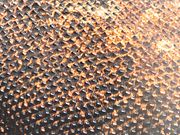



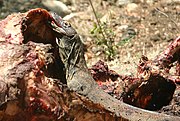









1 comment:
Sangat menarik photo yang disajikan disini.
Peace,
HONDA C70 MOTORCYCLE
Post a Comment